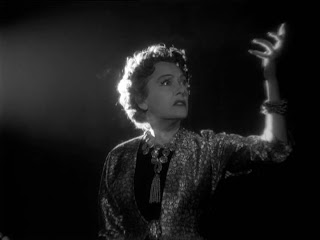You know the story of Norma Desmond, the rich and faded 50 year old silent screen star determined to claw her way back through the Hollywood jungle to an on-camera close-up again. Gloria Swanson, who was a silent screen star, gives a ferociously brilliant performance. She's like a diva in peak condition giving a grand opera performance as a mad queen, only it's not an opera. Her voice, carriage, mannerisms, look -- all perfect. She understood the soul and self-deception of Norma. Swanson got her third Oscar nomination for Best Actress thanks to this Billy Wilder film and she totally deserved it. Norma Desmond is a creature of the Hollywood jungle. It shows in the costumes by Edith Head.
This is a story that could only happen in Hollywood where having a car is essential. Three characters live in the same big, strange house. Each one really has been driven to the point of irrationality because of a car.
No other Hollywood actor played a writer as believably as William Holden in the 1950s and 60s. He was just right in a writer's role -- here in Sunset Blvd., the political writer in Born Yesterday, the playwright in Forever Female, the theatre director/writer in The Country Girl, the journalist in Love Is a Many-Splendored Thing and the screenwriter in Paris When It Sizzles. Something in Holden's screen presence had the right stuff for the discipline, temperament and talent of a writer. As Joe Gillis, he's a down-and-out screenwriter who needs work to make the back payments on his car.
He keeps his car hidden away in a parking lot so the bill collectors don't repossess it. Joe lies and tells them he let a friend borrow it. He's spotted driving on the street and speeds off, hiding his car in a garage he notices. It's the garage of Norma Desmond. He's still broke and can't pay the bill. His car does get repossessed.
Joe feels like he's lost his legs. He has no way to get around town and try to hustle up some work. Norma doesn't see what all the fuss is about. Did Joe look in the garage? She's got an Isotta Fraschini. And a chauffeur named Max to drive it. She can take care of Joe if...he'll take care of her. That includes helping her write her comeback script.
Joe does pretty well for an out of work screenwriter in Hollywood. What's the story with Max? He's the mysterious manservant/chauffeur with the German accent who's so devoted to Miss Desmond. Her huge, monstrous movie star ego seems to have dwarfed him.
Max has his own surprising Hollywood story. He is to Norma what Dr. Frankenstein was to The Monster. What secrets does he have in that forgotten Hollywood mansion?
What's unusual about him being the chauffeur in this car? And what happens when modern-day Hollywood has more use for that car than it does for Norma? Folks are driven to moments of irrationality.
With cabs and mass transit like there are in New York City, most of this drama would never have happened. New York writers can get around via subway. Cars make people do crazy things in Southern California. In Sunset Blvd., Billy Wilder directed three renowned directors of classic films from the silent screen era -- Erich von Stroheim as Max...
Buster Keaton as one of Norma's friends who comes over regularly to play cards...
...and Cecil B. DeMille as himself. He directed Norma in some of her hit silent films. She wants him to direct her comeback vehicle. DeMille's assistant has his eye on Norma's vehicle. Not her awful comeback script idea. Her Isotta Fraschini driven by Max.
Gloria Swanson's first Best Actress Oscar nomination came for a silent film role as the star of 1928's Sadie Thompson. Based on the W. Somerset Maugham story about a prostitute under the influence of religion, it was remade as Rain starring Joan Crawford in 1932. As Meet Sadie Thompson, the story was filmed again in 1953 with Rita Hayworth delivering one of her best movie performances as Sadie. Swanson's second Oscar nomination came for a 1929 talkie. We heard her speak in The Trespasser, a film that opens with "Joseph P. Kennedy Presents." Yes, that Joseph P. Kennedy, the father of future president John F. Kennedy. Swanson and Kennedy became "very close friends." The dialogue coach on The Trepasser was Laura Hope Crews. Millions knew her in 1939 as Aunt Pittypat in Gone With The Wind. When The Artist won the Oscar for Best Picture last weekend, the director/writer of that mostly silent black and white film about Hollywood's silent era thanked "Billy Wilder, Billy Wilder, Billy Wilder." When I saw The Artist for the first time, I did indeed think of Norma Desmond's line to Joe Gillis as they watched one of her old movies: "We didn't need dialogue. We had faces!" And cars.











_07.jpg)
